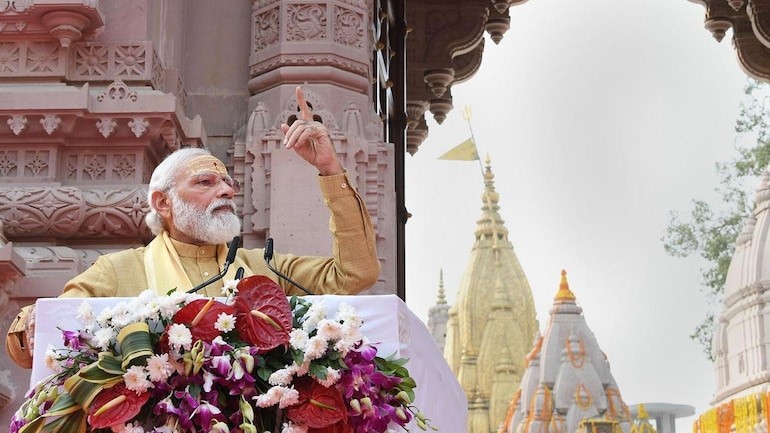
BJP's welfare progs, Hindutva politics & Modi trumped in UP

The BJP’s thumping victory in the Uttar Pradesh assembly election 2022 has come as a big surprise to many, given the large-scale unemployment, high inflation, the menace of loose cattle, and several other hardships faced by the people of this northern state over the past five years.
There is no denying the various failures of the BJP government in Uttar Pradesh (UP), but the party’s delivery of welfare programmes, its Hindutva politics and Modi’s continued popularity have trumped. The BJP has received a vote share of about 45 per cent in this election, even more than the 39.6 per cent it received in the 2017 assembly elections.
When the people were asked their opinion about the state government in UP, many cited the central government benefits they have received – double quota of food rations, free gas cylinder, pucca house etc. Access to welfare measures, no matter how modest, must be greatly valued in a state with high levels of poverty and an abysmal record of public services.
To capitalise on this sentiment, the BJP conducted special drives to mobilise the labharthi (beneficiaries) of its welfare programmes, and at places by applying a ‘tika’ on their foreheads.
Few are questioning the lack of improvements in the areas of health and education. There isn’t any widespread anger in people towards the government’s gross mishandling of COVID-19. In fact, it has worked in the government’s favour as the pandemic seems to have absolved it of any responsibility of improving access and quality of education.
Also read: Uttar Pradesh verdict: Onward ho to a ‘Hindu Rashtra’
One doesn’t hear about any development initiative of the state government. Yogi’s popularity, if any, is largely overshadowed by people’s admiration and gratitude for Modi. Comments like these are not uncommon: “Modi poori duniya mein number ek hai” (Modi is number one in the entire world) and “Main bhagwan se dua karunga ki phir se Modi aaye” (I pray to god that Modi comes back to power).
Others find a distinction between the two leaders meaningless, as they are both from the same party: “Yogi Modi ek hi hai” (Yogi and Modi are the same), “Yogi toh Modi ka hi aadmi hai” (Yogi is Modi’s man only).
The area of governance that people associate most with the Yogi ‘sarkar’ is law and order. Many people credit the current UP government with reducing hooliganism, improving safety of women and increasing the responsiveness of the police. Some insinuate that the poor law and order situation during the Akhilesh ‘sarkar’ was because of the patronage given to the Yadavs and Muslims, which has now ended.
The National Crimes Record Bureau data, however, indicates a spike in the level of crime over the past five years. A possible reason for the divergence between many voters’ views and official data can be that unlike welfare, where most people’s views are formed primarily by their own access to goods and services, opinions on law and order are more likely to be influenced by the dominant narrative.
The stewardship of the state by a saffron-clad religious head with an alarming record of inciting hatred against Muslims is not a matter of concern for most of those who identify themselves as Hindu. Nor is there any significant discussion on state government policies such as requiring Muslim schools to provide visual evidence of their students singing the national anthem on Independence Day or the passage of an anti-religious conversion ordinance for curbing “Love Jihad.”
Also read: BJP weaves Hindutva, caste equations to deliver thumping win
Even Modi’s visible promotion of Hindutva – be it through his participation in the Ram Mandir ceremony in Ayodhya, chanting of ‘Jai Shri Ram’ in election rallies or accusations of the Samajwadi Party protecting Muslim terrorists – are either considered unexceptionable in a country with a Hindu majority or even lauded as courageous acts of rising above “minority appeasement”.
The increasing acceptance of Hindutva amongst Dalits is particularly disheartening, given this ideology’s belief in the supremacy of the upper castes. The subjugation of Dalits is reflected in the actions – and inactions – of UP’s BJP government as well. There were widespread irregularities in the implementation of the reservation policy in the recent recruitment of 69,000 teachers.
Delays in the release of financial assistance by the government has forced many Dalit students to drop out of schools and colleges. Many victims of Dalit atrocities are unable to even register an FIR.
But what alternatives did the Opposition parties offer? The gross failures of the BJP government gave them much fodder to work amongst voters, but they largely missed these opportunities. Notwithstanding token protests against the state and central government’s policies that have cost many their lives or livelihoods, the Samajwadi Party, BSP and Congress have failed to initiate social movements – or even sustained campaigns – to mobilise people on the principles of secularism, justice and equality.
The UP election result is likely to be a bellwether not just for the 2024 general elections, but for the general trend of politics in northern India in the foreseeable future. And that is no reason for cheer.
Ankita Aggarwal is a PhD candidate in political science at the Graduate Center, City University of New York
(The Federal seeks to present views and opinions from all sides of the spectrum. The information, ideas or opinions in the article are of the author and do not reflect the views of The Federal.)


